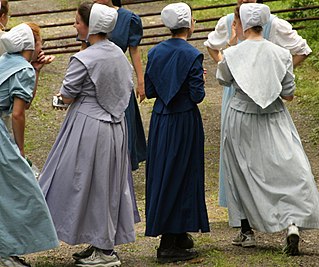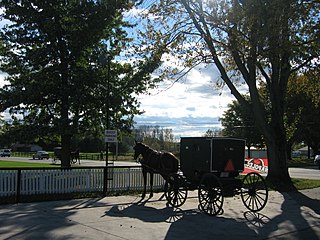Related Research Articles

The Mennonites are members of certain Christian groups belonging to the church communities of Anabaptist denominations named after Menno Simons (1496–1561) of Friesland. Through his writings, Simons articulated and formalized the teachings of earlier Swiss founders, with the early teachings of the Mennonites founded on the belief in both the mission and ministry of Jesus, which the original Anabaptist followers held with great conviction, despite persecution by various Roman Catholic and Protestant states. An early set of Mennonite beliefs was codified in the Dordrecht Confession of Faith in 1632, but the various groups do not hold to a common confession or creed.

Plain people are Christian groups characterized by separation from the world and by simple living, including plain dressing in modest clothing. Many Plain people have an Anabaptist background. These denominations are largely of German, Swiss German, Dutch or other European ancestry. Conservative Friends are traditional Quakers who are also considered plain people; they come from a variety of different ethnic backgrounds.

The Old Order River Brethren are a small Old Order River Brethren denomination of Christianity with roots in the Mennonite Church and the Radical Pietist movement of the Schwarzenau Brethren.

Old Order Mennonites form a branch of the Mennonite tradition. Old Order are those Mennonite groups of Swiss German and south German heritage who practice a lifestyle without some elements of modern technology, who dress plainly and who have retained the old forms of worship, baptism and communion.

Amish Mennonites came into existence through reform movements among North-American Amish mainly between 1862 and 1878. These Amish moved away from the old Amish traditions and drew near to the Mennonites, becoming Mennonites of Amish origin. Over the decades, most Amish Mennonites groups removed the word "Amish" from the name of their congregations or merged with Mennonite groups.
The Stauffer Mennonites, or "Pikers", are a group of Old Order Mennonites. They are also called "Team Mennonites", because they use horse drawn transportation. In 2015 the Stauffer Mennonites had 2,010 adult members.

The Groffdale Conference Mennonite Church, also called Wenger Mennonites, is the largest Old Order Mennonite group to use horse-drawn carriages for transportation. Along with the automobile, they reject many modern conveniences, while allowing electricity in their homes and steel-wheeled tractors to till the fields. Initially concentrated in eastern Lancaster County, Pennsylvania, their numbers had grown to 22,305 people resided in eight other states as of 2015. They share the pulpit with the Ontario Mennonite Conference but have some differences in Ordnung.

The Amish are a group of traditionalist Christian church fellowships with Swiss German and Alsatian Anabaptist origins. They are closely related to Mennonite churches. The Amish are known for simple living, plain dress, Christian pacifism, and slowness to adopt many conveniences of modern technology, with a view to not interrupt family time, nor replace face-to-face conversations whenever possible. The Amish value rural life, manual labor, humility, and Gelassenheit, all under the auspices of living what they interpret to be God's word.
The Orthodox Mennonites, also called Wellesley Orthodox Mennonites and Huron Orthodox Mennonites, are two groups of traditional Old Order Mennonites in Canada and the US with about 650 baptized members. Even though plain to a very high degree and primitivist concerning technology, they are rather intentionalist minded than ultra traditional. Since 1999 they were joined by several other Old Order Mennonite communities.

The Weaverland Conference, also called Horning Church or Black-bumper Mennonites is a Christian denomination of Old Order Mennonites who use cars.
Joseph Wenger (1868-1956) was an Old Order Mennonite preacher, who, in the 1927 schism of the Weaverland Old Order Mennonite Conference was ordained bishop by bishops in Indiana, Michigan, and Virginia, and made head of a new branch broken from the Weaverland Conference. The branch, which split from Weaverland over the issue of adopting the automobile, became formally known as the Groffdale Conference Mennonite Church, the congregation where Wenger preached, but is also informally known as the Wenger Church.
The Noah Hoover Mennonites, called "Old Order Mennonite Church (Hoover)" by the Mennonite World Conference, and sometimes called "Scottsville Mennonites”, are a group of very plain Old Order Mennonites that originally came from the Stauffer Mennonites and later merged with several other groups. Today it is seen as an independent branch of Old Order Mennonites. The group differs from other Old Order Mennonites by having settlements outside the US and Canada and by attracting new members from other groups on a larger scale. They have more restrictions on modern technology than all other Old Order Mennonite groups. They are rather intentionalist minded than ultra traditional.
The Ohio-Indiana Mennonite Conference, also called Wisler Mennonites, is an Old Order Mennonite church body, whose Ordnung allows the ownership and private use of cars. They are quite similar to the Weaverland Old Order Mennonite Conference.
The Ontario Mennonite Conference is a moderate Old Order Mennonite group in the Canadian province of Ontario, that was formed in 1889 as a reaction to modernizing trends among the Mennonites in Ontario. The members use horse and buggy for transportation. As of 2020, they also have a colony in the Canadian province of Prince Edward Island.
The John Dan Wenger Mennonites are an Anabaptist Christian denomination that belongs to the Old Order Mennonites. They use horse and buggy transportation and are mainly located in Virginia. Under the leadership of Bishop John Dan Wenger, they separated from the Virginia Old Order Mennonite Conference in either 1952 or 1953.

The Byler Amish, also called Alt Gemee, are a small conservative subgroup of the Amish. They are known for the yellow color of their buggies, which earned them the nickname "yellow-toppers" and for wearing only one suspender. They are the oldest Old Order Amish affiliation that separated for doctrinal and not for geographical reasons.
The Old Order Movement is a religious movement to preserve the old ways of Anabaptist religion and lifestyle. Historically, it emerged in the second half of the 19th century among the Amish, Mennonites of South German and Swiss ancestry as well as the Schwarzenau Brethren in the United States and Canada. The movement led to several Old Order divisions from mainstream Anabaptist groups between 1845 and 1901. All Old Order groups that emerged after 1901 divided from established Old Order groups or were formed by people coming from different Old Order groups. The highly conservative Old Colony Mennonites and the Hutterites were not directly connected to this movement.
The Old Beachy Amish or Old Beachy Amish Mennonites, also called Midwest Beachy Amish Mennonites, are a Plain, car-driving Beachy Amish group, that preserves the old ways of the Beachy Amish including the German language. They live in Kentucky and Illinois. They are part of the Amish Mennonite movement in a broader sense, but they are not an organized denomination.
Charity Ministries, also called Charity Christian Fellowship, is a network of churches that was formed in 1982 in Lancaster County, Pennsylvania. In the early years it was more of a spiritual movement than a church. Most members have roots in Plain Anabaptist groups and the network is seen as Anabaptist by Kraybill and Hostetter, even though they do not identify as Mennonite themselves.
The Kauffman Amish Mennonites, also called Sleeping Preacher Churches or Tampico Amish Mennonite Churches, are a plain, car-driving branch of the Amish Mennonites whose tradition goes back to John D. Kauffman (1847-1913) who preached while being in a state of trance and who was seen as a "sleeping preacher". In 2017 the Kauffman Amish Mennonites had some 2,000 baptized members and lived mainly in Missouri and Arkansas. In contrast to other Amish Mennonites they have retained their identity over the last hundred years and also largely the Pennsylvania German language and other Amish Mennonite traditions from the late 1800s.
References
- ↑ "James O. Lehman: Amish Anabaptists and Mennonites in Virginia, A Directory of Groups, Conferences and Congregations in Shenandoah Mennonite Historian, Winter 2012, page 5" (PDF).
- ↑ Stephen Scott: An Introduction to Old Order and Conservative Mennonite Groups, Intercourse, PA 1996, pages 24-25.
- ↑ Stephen Scott: An Introduction to Old Order and Conservative Mennonite Groups, page 33.
- ↑ "James O. Lehman: 2010 Directory of Mennonites, Amish and Anabaptist Groups in Virginia, in Shenandoah Mennonite Historian, Winter 2010, pages 6/7" (PDF).
- ↑ "James O. Lehman: Amish, Anabaptists and Mennonites in Virginia, A Directory of Groups, Conferences and Congregations, in Shenandoah Mennonite Historian, Winter 2012, page 5" (PDF).
- ↑ Donald B. Kraybill (2010). Concise Encyclopedia of Amish, Brethren, Hutterites and Mennonites. Johns Hopkins University Press. p. 247.
- ↑ "James O. Lehman: Amish Anabaptists and Mennonites in Virginia, A Directory of Groups, Conferences and Congregations in Shenandoah Mennonite Historian, Winter 2012, page 6" (PDF).
- ↑ "Old Order Mennonites of Virginia - GAMEO". gameo.org.
- ↑ Stephen Scott: An Introduction to Old Order and Conservative Mennonite Groups, page 30.
- ↑ Donald B. Kraybill (2010). Concise Encyclopedia of Amish, Brethren, Hutterites and Mennonites. Johns Hopkins University Press. pp. 247, 258.
- ↑ "James O. Lehman: Amish, Anabaptists and Mennonites in Virginia, A Directory of Groups, Conferences and Congregations, in Shenandoah Mennonite Historian, Winter 2012, page 6" (PDF).